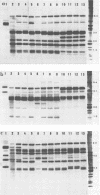Abstract
The genetic relatedness of Legionella longbeachae isolated in Australia since 1987 was investigated by restriction fragment length polymorphism (RFLP) analysis and allozyme electrophoresis. Three radiolabeled probes were used in Southern hybridizations for the RFLP studies. They were Escherichia coli 16S and 23S rRNA and cloned fragments of L. longbeachae selected empirically from genomal banks in lambda and a cosmid. The legionellae included in the study comprised 11 Legionella longbeachae serogroup 1 organisms isolated from humans, 28 L. longbeachae serogroup 1 isolates from environmental sources, and 3 L. longbeachae serogroup 2 environmental isolates. These were compared with the American Type Culture Collection reference strains of both serogroups and some other related Legionella species. Results of allozyme and RFLP analysis showed that all the isolates from humans and all but three of the environmental L. longbeachae serogroup 1 isolates were closely related. They were also closely related to L. longbeachae serogroup 1 ATCC 33462. There was wider variation among the three L. longbeachae serogroup 2 environmental isolates. One of these was closely related to L. longbeachae serogroup 2 ATCC 33484. RFLP studies with the rRNA probe provided the most discrimination among isolates but did not distinguish between the two serogroups.
Full text
PDF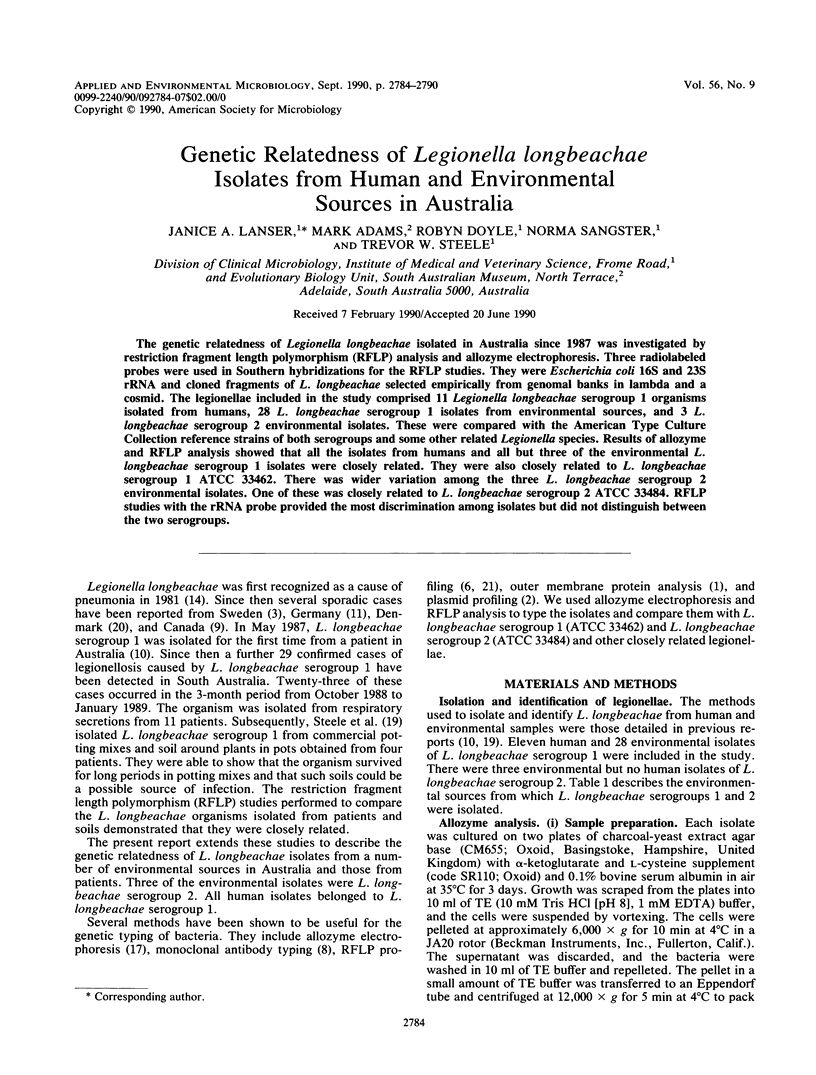
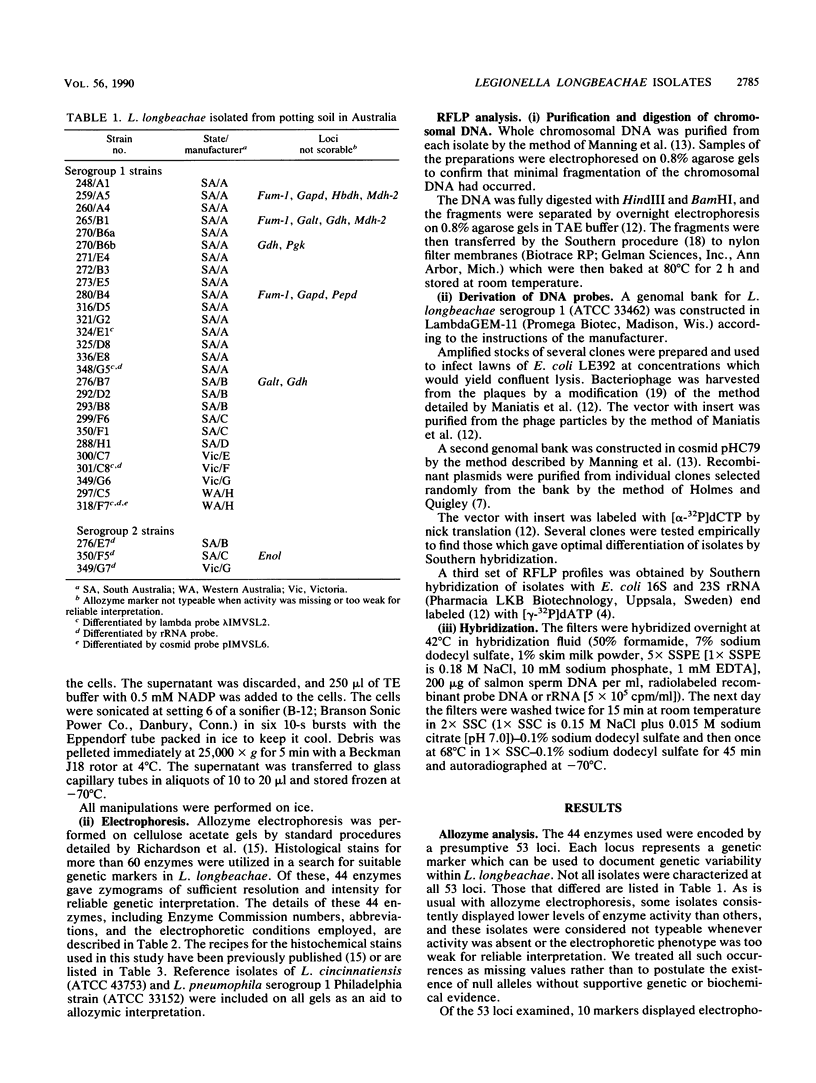
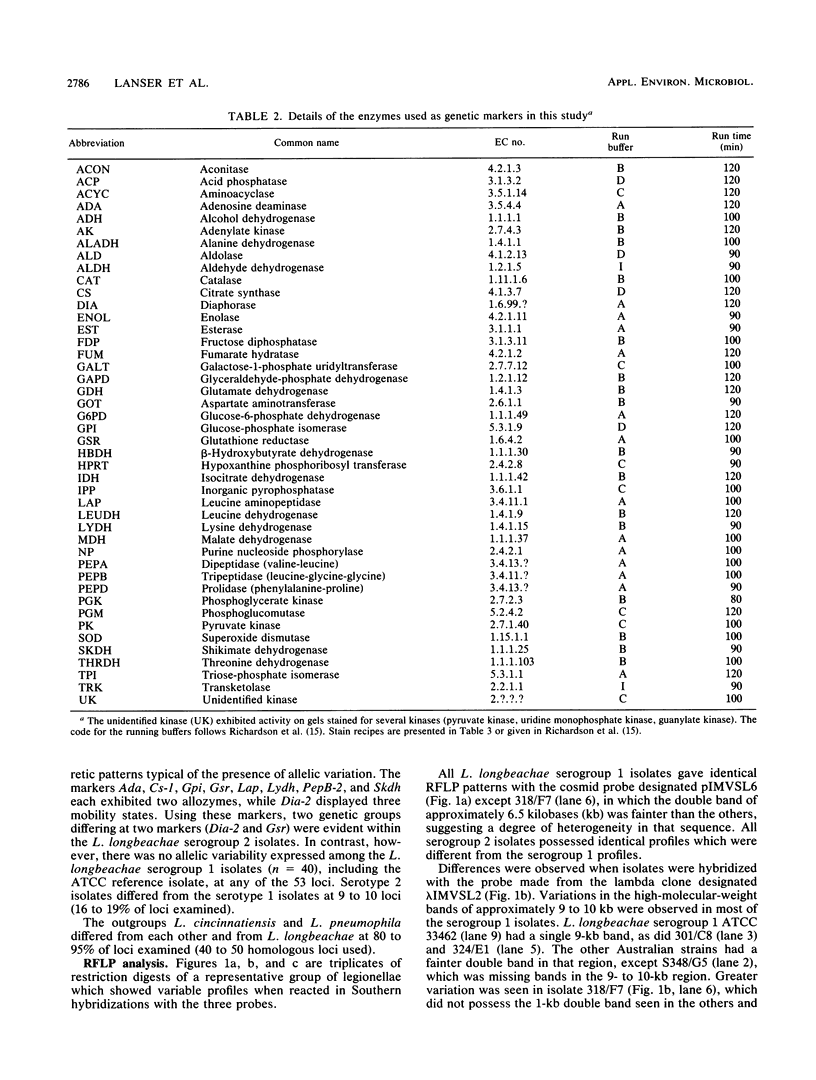
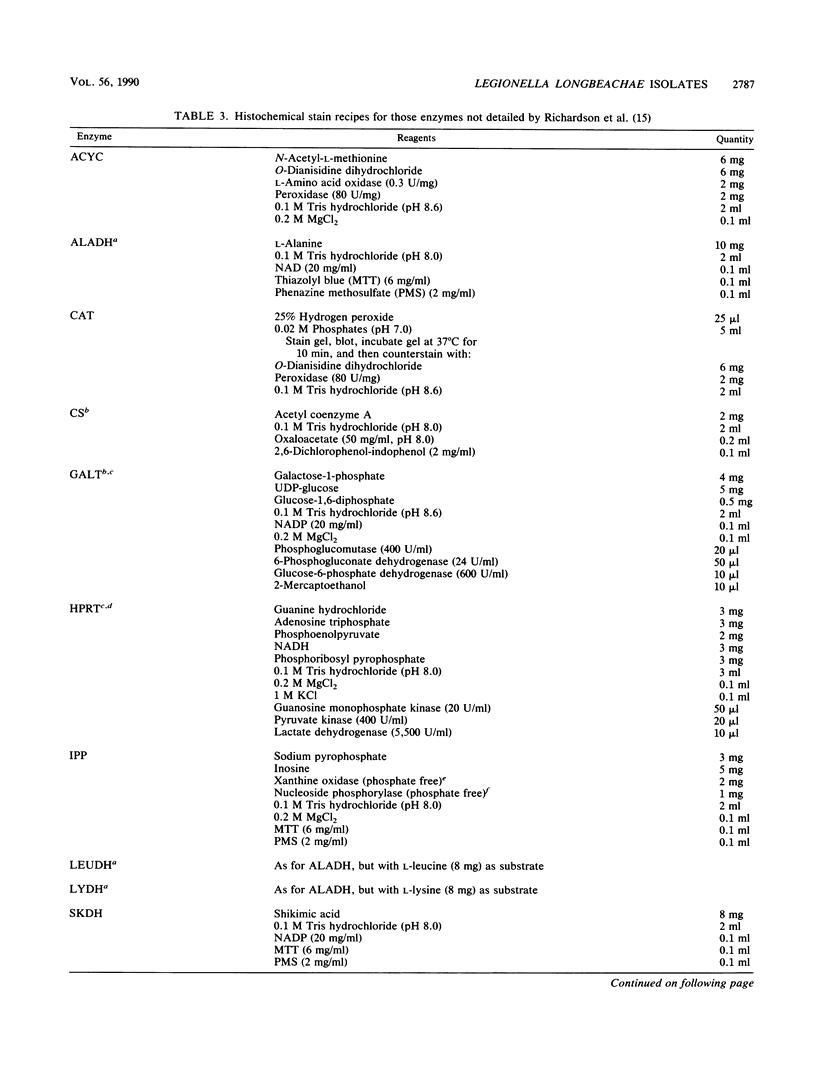
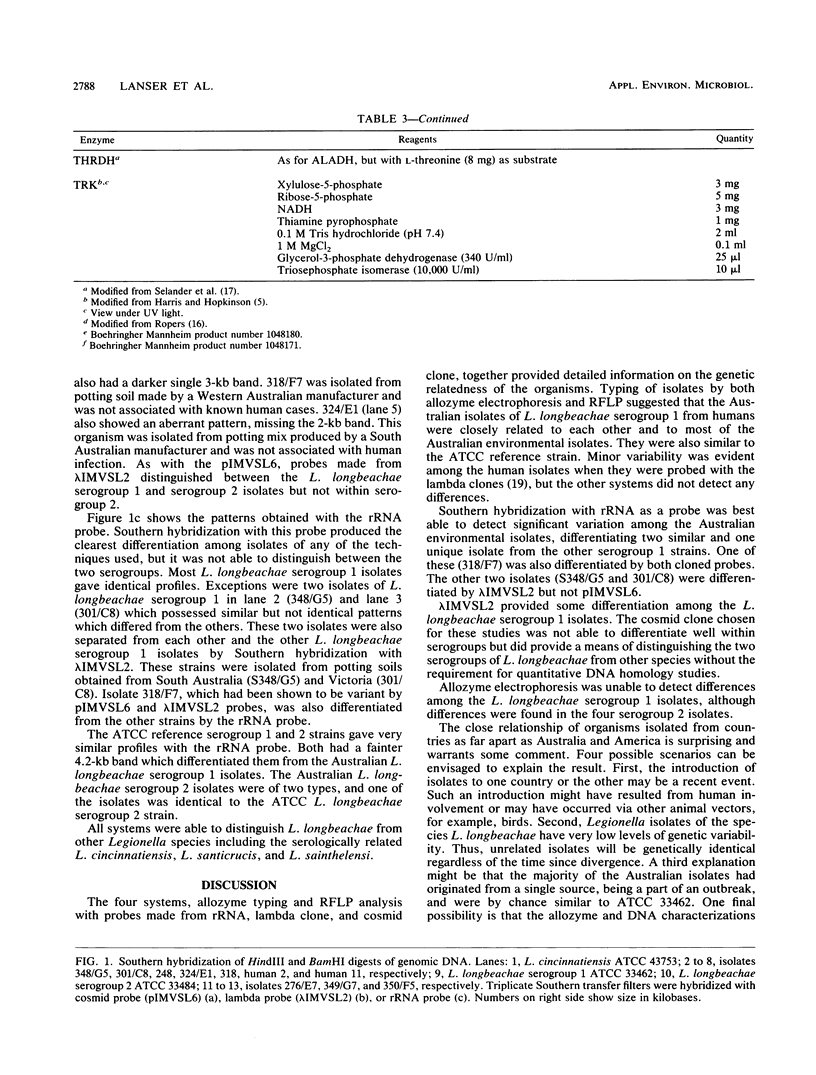
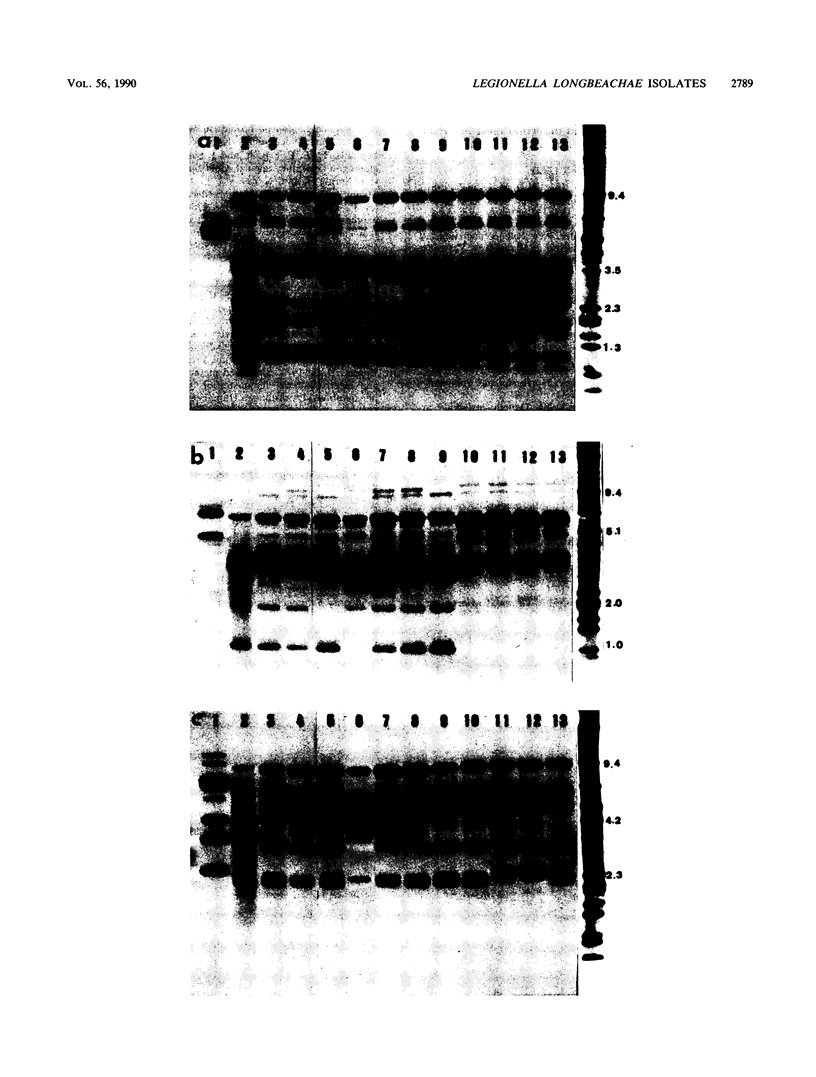
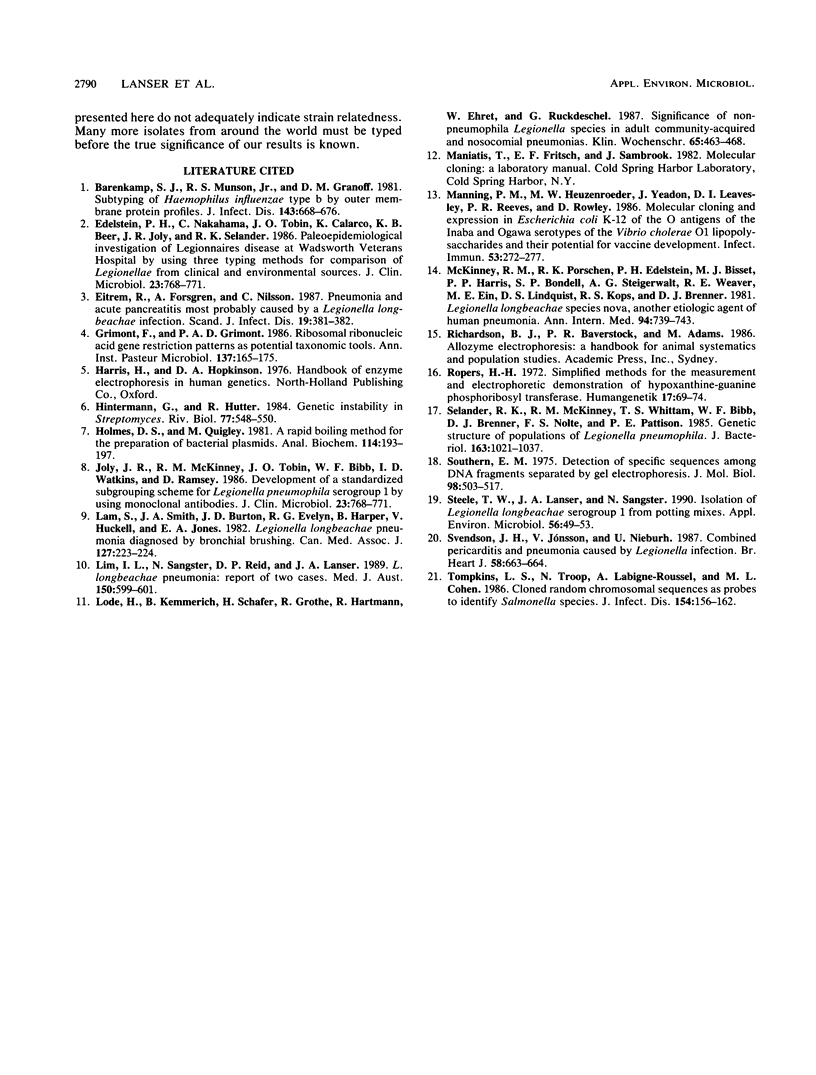
Images in this article
Selected References
These references are in PubMed. This may not be the complete list of references from this article.
- Barenkamp S. J., Munson R. S., Jr, Granoff D. M. Subtyping isolates of Haemophilus influenzae type b by outer-membrane protein profiles. J Infect Dis. 1981 May;143(5):668–676. doi: 10.1093/infdis/143.5.668. [DOI] [PubMed] [Google Scholar]
- Eitrem R., Forsgren A., Nilsson C. Pneumonia and acute pancreatitis most probably caused by a Legionella longbeachae infection. Scand J Infect Dis. 1987;19(3):381–382. doi: 10.3109/00365548709018486. [DOI] [PubMed] [Google Scholar]
- Grimont F., Grimont P. A. Ribosomal ribonucleic acid gene restriction patterns as potential taxonomic tools. Ann Inst Pasteur Microbiol. 1986 Sep-Oct;137B(2):165–175. doi: 10.1016/s0769-2609(86)80105-3. [DOI] [PubMed] [Google Scholar]
- Holmes D. S., Quigley M. A rapid boiling method for the preparation of bacterial plasmids. Anal Biochem. 1981 Jun;114(1):193–197. doi: 10.1016/0003-2697(81)90473-5. [DOI] [PubMed] [Google Scholar]
- Joly J. R., McKinney R. M., Tobin J. O., Bibb W. F., Watkins I. D., Ramsay D. Development of a standardized subgrouping scheme for Legionella pneumophila serogroup 1 using monoclonal antibodies. J Clin Microbiol. 1986 Apr;23(4):768–771. doi: 10.1128/jcm.23.4.768-771.1986. [DOI] [PMC free article] [PubMed] [Google Scholar]
- Joly J. R., McKinney R. M., Tobin J. O., Bibb W. F., Watkins I. D., Ramsay D. Development of a standardized subgrouping scheme for Legionella pneumophila serogroup 1 using monoclonal antibodies. J Clin Microbiol. 1986 Apr;23(4):768–771. doi: 10.1128/jcm.23.4.768-771.1986. [DOI] [PMC free article] [PubMed] [Google Scholar]
- Lam S., Smith J. A., Burton J. D., Evelyn R. G., Harper B., Huckell V., Jones E. A. Legionella longbeachae pneumonia diagnosed by bronchial brushing. Can Med Assoc J. 1982 Aug 1;127(3):223–224. [PMC free article] [PubMed] [Google Scholar]
- Lim I., Sangster N., Reid D. P., Lanser J. A. Legionella longbeachae pneumonia: report of two cases. Med J Aust. 1989 May 15;150(10):599–601. doi: 10.5694/j.1326-5377.1989.tb136700.x. [DOI] [PubMed] [Google Scholar]
- Lode H., Kemmerich B., Schäfer H., Grothe R., Hartmann R., Ehret W., Ruckdeschel G. Significance of non-pneumophila Legionella species in adult community-acquired and nosocomial pneumonias. Klin Wochenschr. 1987 May 15;65(10):463–468. doi: 10.1007/BF01712839. [DOI] [PubMed] [Google Scholar]
- Manning P. A., Heuzenroeder M. W., Yeadon J., Leavesley D. I., Reeves P. R., Rowley D. Molecular cloning and expression in Escherichia coli K-12 of the O antigens of the Inaba and Ogawa serotypes of the Vibrio cholerae O1 lipopolysaccharides and their potential for vaccine development. Infect Immun. 1986 Aug;53(2):272–277. doi: 10.1128/iai.53.2.272-277.1986. [DOI] [PMC free article] [PubMed] [Google Scholar]
- McKinney R. M., Porschen R. K., Edelstein P. H., Bissett M. L., Harris P. P., Bondell S. P., Steigerwalt A. G., Weaver R. E., Ein M. E., Lindquist D. S. Legionella longbeachae species nova, another etiologic agent of human pneumonia. Ann Intern Med. 1981 Jun;94(6):739–743. doi: 10.7326/0003-4819-94-6-739. [DOI] [PubMed] [Google Scholar]
- Ropers H. H. Simplified methods for the measurement and electrophoretic demonstration of hypoxanthine-guanine phosphoribosyl transferase. Evidence for dimeric enzyme structure in various mammals. Humangenetik. 1972;17(1):69–74. doi: 10.1007/BF01789603. [DOI] [PubMed] [Google Scholar]
- Selander R. K., McKinney R. M., Whittam T. S., Bibb W. F., Brenner D. J., Nolte F. S., Pattison P. E. Genetic structure of populations of Legionella pneumophila. J Bacteriol. 1985 Sep;163(3):1021–1037. doi: 10.1128/jb.163.3.1021-1037.1985. [DOI] [PMC free article] [PubMed] [Google Scholar]
- Southern E. M. Detection of specific sequences among DNA fragments separated by gel electrophoresis. J Mol Biol. 1975 Nov 5;98(3):503–517. doi: 10.1016/s0022-2836(75)80083-0. [DOI] [PubMed] [Google Scholar]
- Steele T. W., Lanser J., Sangster N. Isolation of Legionella longbeachae serogroup 1 from potting mixes. Appl Environ Microbiol. 1990 Jan;56(1):49–53. doi: 10.1128/aem.56.1.49-53.1990. [DOI] [PMC free article] [PubMed] [Google Scholar]
- Tompkins L. S., Troup N., Labigne-Roussel A., Cohen M. L. Cloned, random chromosomal sequences as probes to identify Salmonella species. J Infect Dis. 1986 Jul;154(1):156–162. doi: 10.1093/infdis/154.1.156. [DOI] [PubMed] [Google Scholar]



